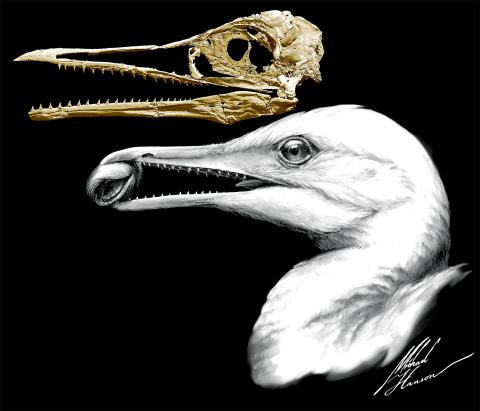Aprimitive seabird that prospered about 85 million years ago along the warm, shallow inland sea that once split North America boasted what scientists are calling a surprising blend of traits from its dinosaur ancestors and modern avian characteristics.
Four new fossils of Ichthyornis, which had both a beak and teeth and lived a lifestyle like modern gulls, offer striking evidence of this Cretaceous Period bird’s important position in avian evolutionary history, researchers said last Wednesday.
While Ichthyornis fossils were first unearthed in the 1870s, the new ones from Kansas and Alabama chalk deposits, including a beautifully preserved skull, reveal far more about it than previously known.

Photo: Reuters
照片:路透
Birds evolved from small feathered dinosaurs. Unlike the earliest-known birds like Archaeopteryx, which lived 150 million years ago, Ichthyornis was a strong flier, its body streamlined, simplified and adapted for flight like modern birds, Yale University paleontologist Bhart-Anjan Bhullar said.
Its primitive characteristics were largely in its skull. “Despite the modernity of its body and wings, it retained almost a full complement of dinosaurian teeth, and it had a strong bite with large, dinosaurian jaw muscles. However, it perceived its world and thought like a bird, with a bird’s enormous eyes and expanded, modern-looking brain,” Bhullar added.
While older primitive birds like Confuciusornis, from 125 million years ago, sported a beak, the small one on Ichthyornis was the first known to have modern attributes like a “pincer tip” for grasping, pecking and fine manipulation. “Its sharp teeth probably would have assisted in holding onto slippery marine prey, while the incipient beak at the tips of its jaws probably would have allowed it to manipulate objects with fine dexterity such as modern birds can do, and preen its feathers,” University of Bath paleontologist Daniel Field said.
Ichthyornis was the size of a tern, with a 60-cm wingspan, and probably ate fish and shellfish. It shared the skies with flying reptiles called pterosaurs when dinosaurs dominated the land. Toothed birds vanished along with the dinosaurs and many other species after an asteroid impact 66 million years ago.
Fossils like those of Ichthyornis and Cretaceous toothed diving bird Hesperornis were cited by 19th century naturalist Charles Darwin as strong support for his theory of evolution.
“Ichthyornis shows the ways in which evolution is both complex and elegant, permissive of individual changes and massive integrated transformations,” Bhullar said. The research was published in the journal Nature.
(Reuters)
大約八千五百萬年前,有一種原始海鳥曾繁衍於一度分隔北美洲的溫暖內陸淺海沿岸,它們來自恐龍祖先與現代鳥類的特徵,呈現如科學家所稱讓人驚訝的混合生物性狀。
魚鳥同時擁有鳥喙與牙齒,過著如同現代海鷗的生活型態。研究人員於上週三表示,四具新的魚鳥化石提供驚人的證據,展現出這種白堊紀時期飛禽在鳥類演化史上的重要地位。
即使魚鳥化石於一八七○年代就已初次出土,但新發現於阿拉巴馬州及堪薩斯州白堊岩沉積層中的魚鳥化石──包括一具保存良好的頭骨──透露出比以往所知的更多資訊。
鳥類演化自小型的披羽恐龍,耶魯大學的古生物學家布哈特-安陽‧布拉爾指出,迥異於目前所知最早的鳥類,例如生活在一億五千萬年前的始祖鳥,魚鳥是更強壯的飛行動物,身體呈流線型且線條更為簡化,像現代的鳥類般適應飛行。
這種生物的原始特徵主要在頭骨部分。布拉爾補充說:「雖然魚鳥身體和翅膀相當具現代性,這類生物仍然保留一整套如恐龍般的牙齒,如恐龍般的大型顎部肌肉則讓它具備相當強的咬合力。然而,魚鳥感知世界和思考的模式都很像鳥,不但有著鳥類的巨大眼睛,也有擴展的腦部結構,看起來相當現代。」
儘管更原始的鳥類,例如一億兩千五百萬年前的孔子鳥屬,已經發展出鳥喙,但是魚鳥的小型喙是目前所知第一種具備現代鳥類屬性的構造,例如用來抓取、啄食、以及執行精巧操控能力的「鑷型尖端」。巴斯大學的古生物學家丹尼爾‧費爾德指出:「魚鳥的尖銳牙齒大概曾協助它們緊緊銜住滑溜的海中獵物,而顎部尖端的初始喙形構造大概曾讓這類生物能夠細緻靈巧地操控物件,像是現代鳥類能夠做到的一般,同時也可以用來梳理羽毛。」
魚鳥的身形大小約如燕鷗,翼展可達六十公分,大概以魚和貝類為食。它曾與翼龍目的飛行性爬蟲類一同翱翔於天際,當時陸地則由恐龍所宰制。在六千六百萬年前,因為一次小行星撞擊地球造成的後續影響,這類有牙齒的鳥類就和恐龍及其它物種一起消失了。
魚鳥以及能夠潛水的白堊紀有齒鳥類「黃昏鳥」等動物化石,曾被十九世紀的自然學家查爾斯‧達爾文引以為證,認為強烈支持他提出的演化論。
布拉爾表示:「魚鳥展現出複雜而洗練的生物演化方式,既容許個體性差異,又可見大規模整合後的變化。」這份研究發表於《自然》期刊。
(台北時報章厚明譯)

In an effort to fight phone scams, British mobile phone company O2 has introduced Daisy, an AI designed to engage phone con artists in time-wasting conversations. Daisy is portrayed as a kindly British granny, exploiting scammers’ tendency to target the elderly. Her voice, based on a real grandmother’s for authenticity, adds to her credibility in the role. “O2” has distributed several dedicated phone numbers online to direct scammers to Daisy instead of actual customers. When Daisy receives a call, she translates the scammers’ spoken words into text and then responds to them accordingly through a text-to-speech system. Remarkably, Daisy

Bilingual Story is a fictionalized account. 雙語故事部分內容純屬虛構。 Emma had reviewed 41 resumes that morning. While the ATS screened out 288 unqualified, she screened for AI slop. She could spot it a mile away. She muttered AI buzzwords like curses under her breath. “Team player.” “Results-driven.” “Stakeholder alignment.” “Leveraging core competencies.” Each resume reeked of AI modeling: a cemetery of cliches, tombstones of personality. AI wasn’t just changing hiring. It was draining the humanity from it. Then she found it: a plain PDF cover letter. No template. No design flourishes. The first line read: “I once tried to automate my

Every May 1, Hawaii comes alive with Lei Day, a festival celebrating the rich culture and spirit of the islands. Initiated in 1927 by the poet Don Blanding, Lei Day began as a tribute to the Hawaiian custom of making and wearing leis. The idea was quickly adopted and officially recognized as a holiday in 1929, and leis have since become a symbol of local pride and cultural preservation. In Hawaiian culture, leis are more than decorative garlands made from flowers, shells or feathers. For Hawaiians, giving a lei is as natural as saying “aloha.” It shows love and

1. 他走出門,左右看一下,就過了馬路。 ˇ He walked outside, looked left and right, and crossed the road. χ He walked outside and looked left and right, crossed the road. 註︰並列連接詞 and 在這句中連接三個述語。一般的結構是 x, y, and z。x and y and z 是加強語氣的結構,x and y, z 則不可以。 2. 他們知道自己的弱點以及如何趕上其他競爭者。 ˇ They saw where their weak points lay and how they could catch up with the other competitors. χ They saw where their weak points lay and how to catch up with the other competitors. 註:and 一般連接同等成分,結構相等的單詞、片語或子句。誤句中 and 的前面是子句,後面是不定詞片語,不能用 and 連接,必須把不定詞片語改為子句,and 前後的結構才相等。 3. 她坐上計程車,直接到機場。 ˇ She took a cab, which took her straight to the airport. ˇ She took a cab and it took her straight